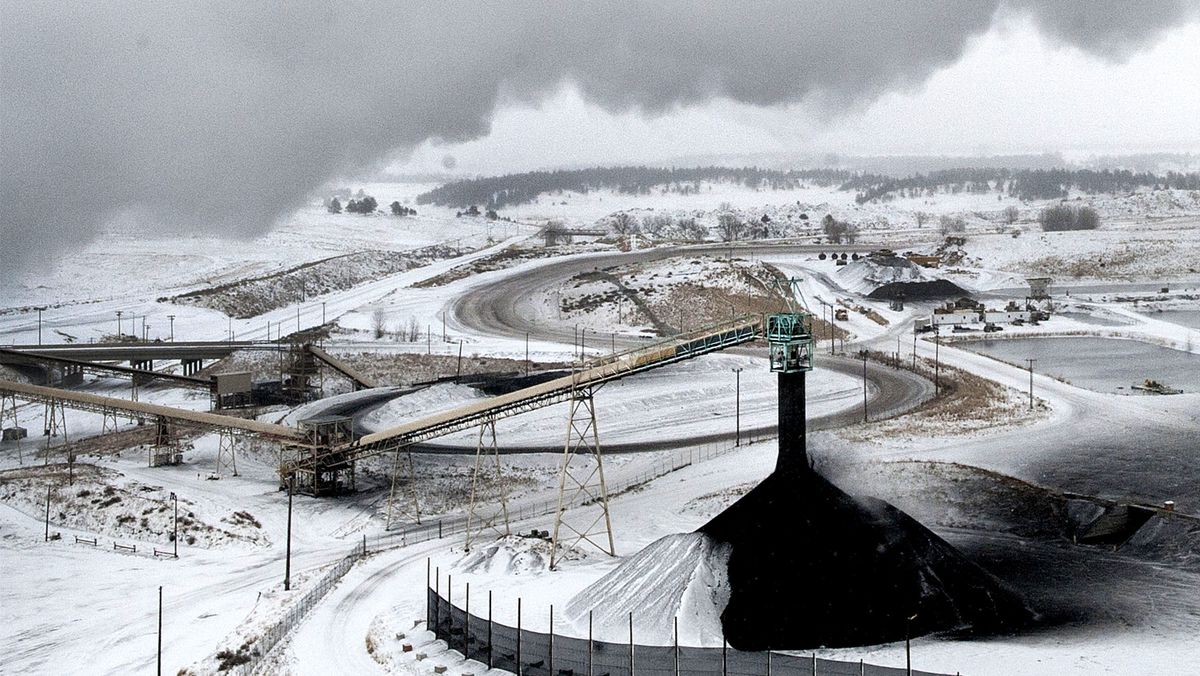Avista makes deal to get out of aging Colstrip power plant in Montana
Coal from the Rosebud Mine travels on a 4.2 mile long conveyor belt to reach coal-fired generators at the Colstrip Steam Electric Station on Tuesday, Feb. 4, 2014. Coal shown here is destined for Units 1 and 2, which are partly owned by Puget Sound Energy. Avista Corp. has a 15% ownership of Units 3 and 4 at the plant. (Kathy Plonka/The Spokesman-Review)Buy a print of this photo
Avista Corp. has a deal to get out of its ownership stake in one of the largest polluters of the Northwest: The Colstrip coal-fired power generation plant in eastern Montana.
The Spokane-based utility agreed to hand over its partial ownership stake in Colstrip to NorthWestern Energy for free. The deal announced last week will take effect on Dec. 31, 2025, which is the last day Avista had to comply with a 2019 Washington law that banned the use of coal-generated electricity.
However, Jason Thackston, a senior vice president at Avista, said the utility had earlier determined that it wasn’t economically feasible to continue owning part of Colstrip beyond 2025, even without the law that required it to end the use of coal.
“Yes, it complies with the legislation,” said Thackston, who is Avista’s chief strategy and clean energy officer, “but it was also the right decision to make from our perspective regardless of that legislation.”
As part of the deal, Avista will hand over to South Dakota-based NorthWestern Energy its 15% share of the plant’s units three and four. Colstrip’s two older units, one and two, were shut down in 2020.
Units three and four, which opened in 1984 and 1986, each have the capacity to generate 778 megawatts of electricity.
Avista receives a combined 222 megawatts from both units, which is about 8% of the electricity the utility needs to meet its customers’ usage, Thackston said.
“For the last several years, Avista has been engaged in conversations with the other five owners of Colstrip to find a solution that would allow us to exit Colstrip by the end of 2025,” he said. “Over that period of time, Avista determined that this opportunity with NorthWestern Energy is the best option.”
NorthWestern CEO Brian Bird praised the arrangement in a news release.
He said the handover fits into his utility’s plan to reach net zero carbon emissions by 2050.
“More resources that can generate power on-demand, 24/7, located in Montana and dedicated to serve Montanans, are needed to meet our responsibility to provide our customers with reliable energy service, keep them safe in all weather conditions and avoid an energy crisis,” Bird said in the release.
Montana Gov. Greg Gianforte, who in 2021 criticized what he called “woke, overzealous regulators in Washington state” who were “punishing the people of Colstrip with their anti-coal agenda,” also praised the deal.
“This development will better ensure Colstrip remains in service throughout its full, useful life, and it’s encouraging for Montanans who rely on the reliable, affordable electricity Colstrip generates,” he said in a statement. “Montana needs Colstrip. I’m very encouraged about this announcement.”
Doug Powell currently works as a clean energy consultant. Up until May 2021, Powell was the senior campaign manager for the Sierra Club’s Beyond Coal initiative.
Powell said Colstrip has historically been one of the top three producers of greenhouse gas emissions in the Northwest.
Any decision to try to prolong its life will eventually cost NorthWestern rate payers in addition to continuing the legacy of pollution, he said.
“It’s a big greenhouse gas polluter, it’s not economical and there are better ways to take care of the communities and workers without harming the environment and the ratepayers,” he said.
Coal town
The massive power plant is located in a small town that shares the plant’s name: Colstrip.
It’s about a two-hour drive east of Billings and north of Lame Deer on the Northern Cheyenne Indian Reservation.
The power plant operates adjacent to the massive open-pit coal mines that feed its boilers. The plant produces about 16 million tons of carbon dioxide and other climate-warming gases each year, according to the U.S. Environmental Protection Agency.
The plant is owned by a group of utilities. Puget Sound Energy, Avista Corp., Portland General Electric and PacificCorp together own 70% of the power plant.
Talen Montana and NorthWestern Energy own the rest until the deal goes through at the end of 2025, when Avista will give up its interest.
But Powell, the former activist, said he had hoped that Avista and Puget Sound Energy would have simply stopped operations at the end of 2025.
“The economics of the plant are not there,” Powell said. Avista and PSE “have not been doing capital upgrades that are necessary.
“Unit 4 has broken down three times in the past 10 years,” he continued. “They are old plants. They need upgrades. How can NorthWestern even afford to run this plant when there are so many cheaper options out there. I can’t understand it.”
Even though Avista is giving up its ownership, it has committed to paying for remediation once the plant finally closes, Thackston said.
“For almost 40 years, we have been part owners of that plant and our customers have received the benefits of that generation,” he said. “We have an obligation today for future decommissioning and remediation costs, whenever those occur.”
Powell praised Avista for committing $3 million to assist the community of Colstrip in finding a different economic model after the plant ceases operations.
“That’s good because we absolutely have to take care of the workers,” Powell said. “Then you also have to balance out fairness to ratepayers.”
Powell said he fears the plant may end up hurting the remaining customers it serves.
“I’m glad for the jobs. But the ratepayers are going to take it on the chin because they going to have to prop up that plant to keep it economical,” he said.
Replacing power
Thackston said Avista has made three more agreements to purchase more dam-generated electricity to help replace the 222 megawatts it eventually will lose from Colstrip.
Every two years, the utility updates what it calls its integrated resource plan. In it, Avista outlines how it will bring on different power sources to meet its goal to serve customers with 100% clean electricity by 2045.
Currently, about half of Avista’s power comes from dams. The next largest producer, about 34%, comes from two natural-gas fired turbines. One is located on the Rathdrum Prairie and another is located in Boardman, Oregon.
In 2020, Avista more than doubled its wind-power capacity to about 10% of its total power generation when it opened the Rattlesnake Flat Wind Farm about 15 miles south of Ritzville.
Lastly, Avista also gets about 2% of its electricity from a biomass facility in Kettle Falls.
But wind may hold the greatest potential.
Thackston noted that Avista is retaining the transmission lines that currently send the power from Colstrip to homes in Washington and Idaho.
“After 2025, we are retaining that transmission capacity,” he said. “That is not going along with the (NorthWestern) deal.”
He noted that the cost to produce wind electricity continues to get cheaper.
“We have identified that there could be value in having some wind generation coming from Montana,” Thackston said. “To the extent that we are able to identify wind opportunities in Montana, we can use the transmission to our service territory that was previously sending Colstrip generation to our service territory.”

